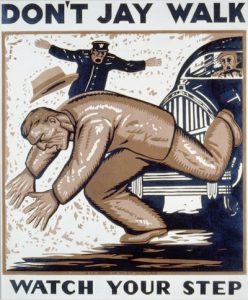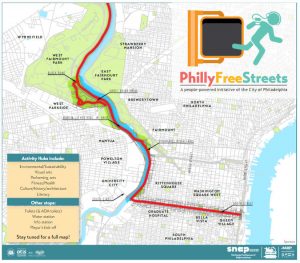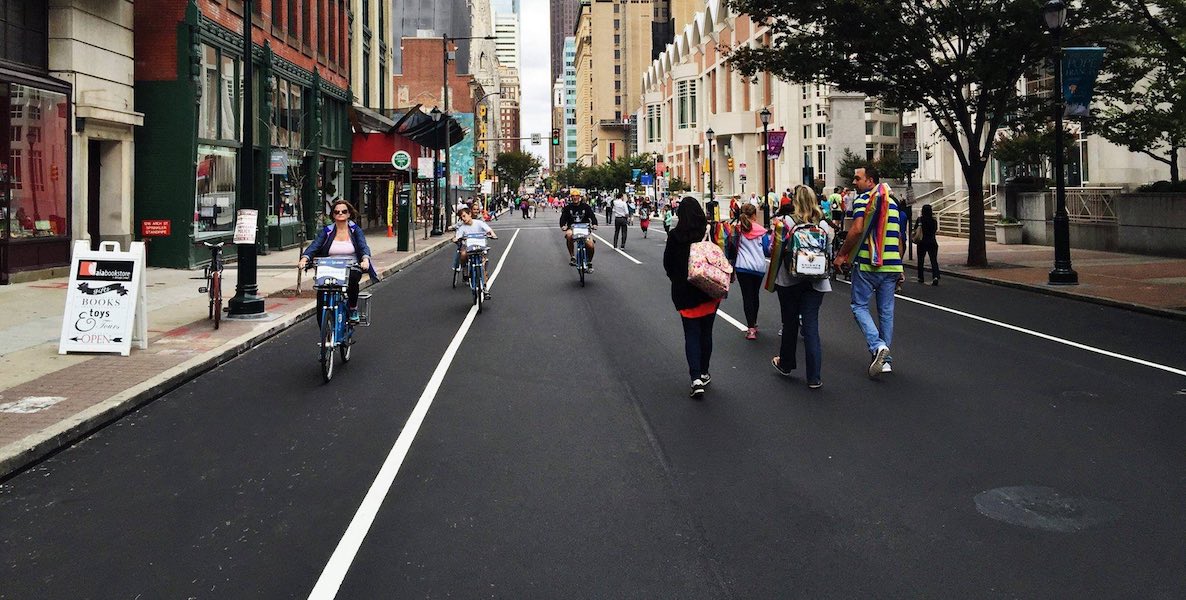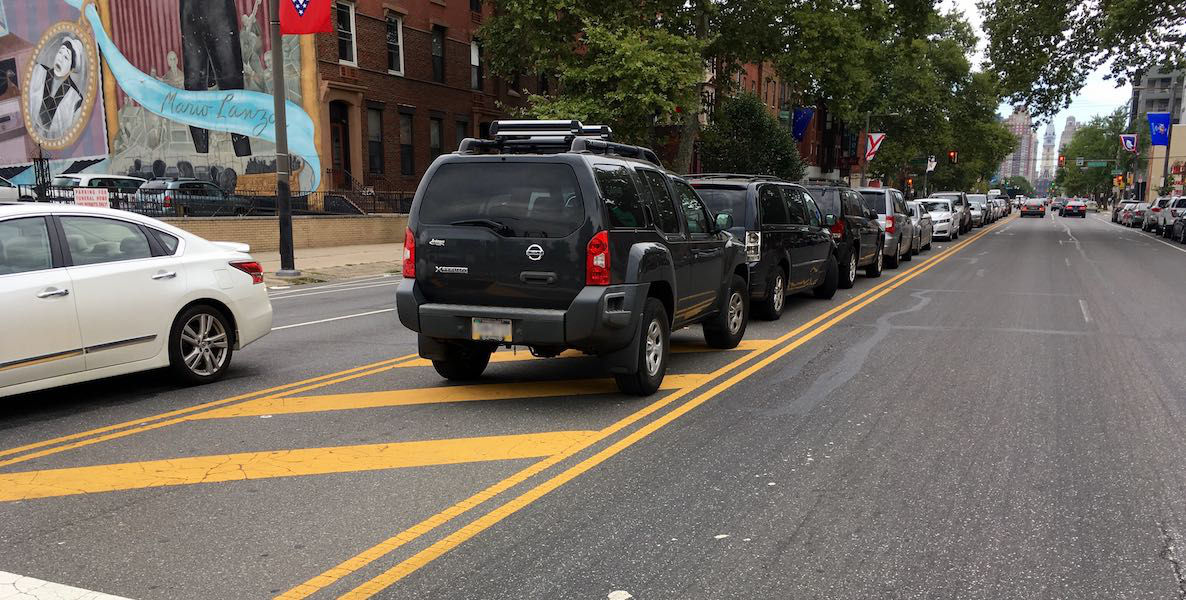Of all the blessings Pope Francis gave to Philadelphia in his visit last September, perhaps the most unexpected will happen this Saturday, during Philly Free Streets Day. As you’ll recall, to prepare for this monumental visit, Philadelphia city officials announced comprehensive traffic control measures that scared many residents into leaving. But with fewer visitors than expected, the conditions were perfect for those who remained to magically rediscover their city as a walkable and car-free utopia. Soon after, Open Streets PHL launched to capitalize on this public gift.
But this new movement—creating what Mayor Jim Kenney calls a “safe environment for physical activity, learning, and bettering the futures of thousands of children” on 10 miles of city street tomorrow—is actually the story of a public space we lost long ago.
At the turn of the century, streets were already vibrant gathering spaces. “Until the 1920s,” writes historian Peter Norton, author of Fighting Traffic: The Dawn of the Motor Age in the American City, “cars were at best uninvited guests.” But as automobile sales rose, so did fatalities. Accidents involving children, especially, were publicly mourned in the same way we mourn the 2012 Sandy Hook shootings—as needless deaths that demanded a public conversation, and calls against inaction. As we prepare for our first ever Philly Free Streets Day, let’s take a look back at the dramatic history of the city street.
E.B. Lefferts understood that in America, you can’t enforce a law that people don’t believe in. You have to make them believe first. Lefferts asked law enforcement not to arrest jaywalkers, but instead to blow their police whistles at jaywalkers, attracting attention and ridicule.
In 1906, the average state speed limit was 10 miles per hour. The street was a perfectly safe place for children to play, and safe for anyone who wanted to cross. But between 1907 and 1923, with the rise of the Model-T, auto-fatalities across the country rose from 500 to 16,000 per year, with many involving children. No matter the circumstance, it was the automobile—the imposing, screaming, metal machine—that was always considered at fault. “Mothers of children killed in the streets,” reports Jesse Dukes for the 99% Invisible podcast, “were given a special white star to honor their loss.” Consider this passage from the November 23, 1924, issue of The New York Times:
“The horrors of peace appear to be [more] appalling than the horrors of war. The automobile looms up as a far more destructive piece of mechanism than the machine gun. The reckless motorist deals more death the artilleryman. The man in streets seems less safe than the man in the trench. The greatest single lethal factor is the automobile. It left shambles in its wake as it coursed through 1923.”
Anti-automobile sentiment swelled. Citizens in Cincinnati collected 40,000 signatures in support of a 25 mile per hour limit on all city vehicles. City managers considered other anti-auto measures, such as outlawing curbside parking, or requiring that cars make right-angle turns around obstacles. Newspapers at the time often depicted the grim reaper driving a Model-T over hordes of people. In the streets, people and cars didn’t mix, and it was the car that had to go.

Auto manufacturers took notice. They realized that if they were going to continue sales, they would need to change public opinion. Loosely banded together under the name Motordom, auto interests lobbied Congress for appropriations for better roads, and for pro-auto legislation. But E.B. Lefferts, head of the automobile club of Southern California, knew that they couldn’t just change laws. As Norton explains, “before the city street could be physically reconstructed to accommodate motor vehicles, it had first to be socially reconstructed as a modern thoroughfare.” Motordom enacted two public campaigns that continue to define our streets.
The first breakthrough was to shift the blame from drivers to pedestrians. To do this, they introduced a new word into the public imagination. If “jay” was a derogatory term for an empty-headed chatterbox from the country (like a bluejay), then a “jay-walker” was this country bumpkin who, overwhelmed by the big city lights, stepped dangerously into traffic. Alongside newspaper and radio ads, Motordom found creative ways to popularize their new word. During a 1921 safety week in Grand Rapids, Michigan, local Boy Scouts were recruited to issue cards to offenders, that read, “Did you know you were jaywalking?” Other text on the card would go on to explain what jaywalking was, and why it was wrong. And how successful was this campaign? While jaywalker entered the Oxford dictionary in 1921, I bet you’ve never heard any of the counter-campaigns: the “jay driver,” the “joy rider,” the “flivverboob.”
Motordom also successfully passed an anti-jaywalking ordinance in Los Angeles in 1924, making jaywalking punishable by fine, and jail time. But again, E.B. Lefferts understood that in America, you can’t enforce a law that people don’t believe in. You have to make them believe first. Lefferts asked law enforcement not to arrest jaywalkers, but instead to blow their police whistles at jaywalkers, attracting attention and ridicule. Norton explains, “…to Lefferts it was more important that the onlooker sees this person being ridiculed, than actually [converting] this individual to correct crossing behavior. The onlookers are going to witness this ridicule and think, I don’t want to get that kind of ridicule, so I’m going to cross carefully.” By the 1930s, anti-jaywalking legislation had become the norm.
Fast forward to today, where cars rule the streets. This is, partly, a matter of economics: As Paul Levy pointed out this summer, a lack of jobs in town means some 39 percent of Philadelphia residents commute to the suburbs. That’s thousands of people who depend on their vehicle, navigating streets to get to work. Furthermore, without good streets (or refrigeration), bringing produce from rural to urban areas quickly before they spoil, is also impossible. Cars, and the ability to drive them, contributes tremendously to a city’s quality of life.
An opportunity to enjoy a car-free street is the first glimmer into what’s possible. But to change hearts, we need to feel the joy of crossing a street without fear. We need to bottle that same magic of the Pope Francis’ unexpected gift to Philadelphia. Without these warm, gooey feelings, the idea that enjoying the streets is a political action against the last 100 years of automobile advocacy has no legs.
But that doesn’t mean we can’t share the streets way more than we do now. As modern life trends towards urbanization, we are beginning to think more, and more radically, about the quality of life in the inner city. In Bogota, Mayor Enrique Peñalosa has called for a plan to make every other street car-free. Programs like SFPark are using technology to assess the cost of the location and space that an idle car occupies, to keep 15 percent of spaces free on every block. The Vision Zero movement in cities around the country is a revival of the “jay driver” campaigns of yesteryear—putting the onus on drivers to keep walkers safe, not vice versa. In Philadelphia, Mayor Kenney has signed on to Vision Zero, promising to cut pedestrian deaths and serious injuries in half by the end of his first term.
This is not an easy shift—just look at what happened this summer when 5th Square suggested eliminating parking from the Broad Street median in South Philly. Emotions ran high.
That’s why Open Streets PHL could take a lesson from Motordom. Changing the way cities work means changing hearts, even using shame or the fear of public ridicule to get the message across.
Open Streets PHL founder Jon Geeting hopes the city hosts these car-free festivals at least three times a year. And thanks to Pope Francis, that may be possible. But Geeting also hopes Free Streets Days will “help change Philadelphians’ conceptions of what our public streets are for.” This is the reverse of what Motordom has fought since 1924, something that gets harder every time we play “Red Light, Green Light” with our kids, and that requires an incredible re-imagination of what, and who, the street is for.
This Saturday’s Philly Free Streets Day is a start. An opportunity to enjoy a car-free street is the first glimmer into what’s possible. But Free Streets can’t just be a block party. To change hearts, we need to feel the joy of crossing a street without fear. We need to bottle that same magic of the Pope Francis’ unexpected gift to Philadelphia. Without these warm, gooey feelings, the idea that enjoying the streets is a political action against the last 100 years of automobile advocacy has no legs. Public space is a reflection of who we are, what values we hold dear, and how we want to live. Public space is all around us, but it is never neutral. So this Saturday, from 8 a.m. to 1 p.m., practice yoga in a turning lane, or picnic on the yellow lines of MLK Drive. In the spirit of E.B. Lefferts: You’d be a total idiot not to join in.
Header photo courtesy of Open Streets PHL





